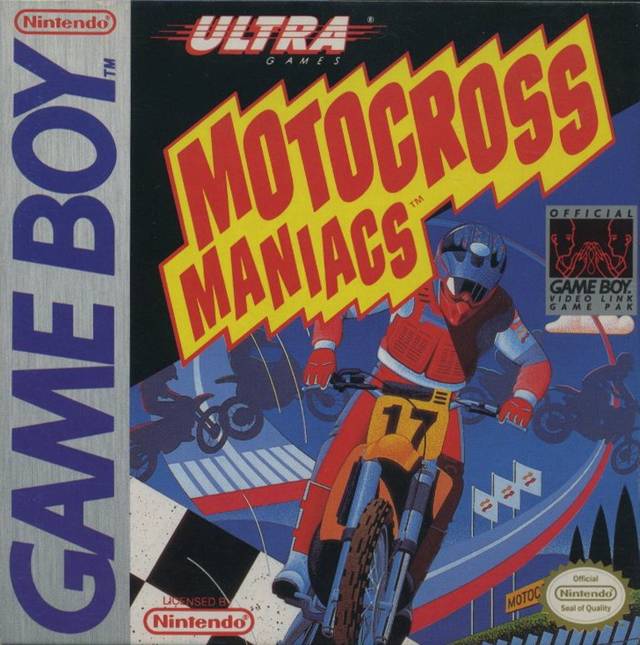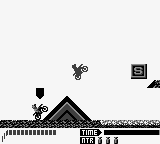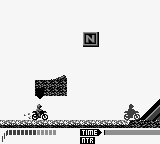Motocross Maniacs

- Japanese release in September 1989
- North American release in January 1990
- European release in 1990
- Developed by Konami
Manic Motocross

In high school, I had a friend who just loved motocross games. During lunchtime, he religiously played Elasto Mania at our school’s computer lab, which he played because he appreciated all things motorsports. He would ride a bike with his brothers, so he liked motocross games. By the way, Elasto Mania kind of took over my high school’s computer lab for a solid month. Every friend I had was obsessed with it and played it during lunch; I couldn’t care less.
To get back to my friend who liked motocross, his appreciation for Elasto Mania always felt weird to me, since there was nothing similar between riding a motorcycle and playing Elasto Mania: the game is about managing a bendy suspension between both wheels of your bike to navigate complex 2D geometry where you find and gather apples, of all things. You pull tricks like hanging the top wheel of the bike on a small notch to gather momentum and shoot your bike across gaps. I don’t have to say that this has nothing to do with riding a bike in real life. Elasto Mania is a physics-based gauntlet with no basis in reality. It’s also really hard.
While I was thinking about all this useless nonsense, I was reminded of the idea I expressed in my Toy Story Racer article; that 3D was most beneficial to driving games. That’s one of the reasons they were so prevalent in arcades, on powerful dedicated arcade boards that could produce 3D graphics. A 3D racing game could properly convey what it really meant to drive a car or a motorcycle. A 3D environment could adequately convey the intricate relationship between the road and your vehicle’s wheels. On consoles during this era, we were stuck with all sorts of games using racing as a situation, but whose gameplay did not resemble driving at all. Like our game here, Motocross Maniacs, which has nothing to do with driving a motocross bike. It’s an opinionated platformer.
What It’s About
Imagine if Mario had to gather boost items that he needed to use to gather enough momentum to jump above the pipes in the game. That’s Motocross Maniacs in a nutshell. You are presented with eight simple levels, filled with one-use boosts that you have to collect if you ever wish to finish a level before the timer runs out. You have to use your boosts to clear jumps and loops where more boosts and other time-saving items are collected.
The levels have multiple routes stacked on top of one another, and the best route is generally the top one. Part of the challenge is to reach the top of the level and stay there, since that’s where the quickest route and the most items are found. It’s surprisingly reminiscent of the Sonic games on Mega Drive/Genesis. I guess it’s a natural level layout for a platformer based on momentum.
This general concept of finding paths that give you a sustainable number of boosts is interesting, but it introduces some undue friction. What happens when you run out of boosts? Well, tough luck. You can get completely stuck during a game because you made a mistake. You’re therefore always on edge, wary of losing all your progress because of one misstep. Being on edge is not a bad feeling to have, but you will deal with very harsh failure, however. When you’re left without any boosts needed to clear a jump, you can get stuck with no choice but to wait for the timer to run out to try again. That flaw makes it very hard to like the game. Fortunately you can reset the console for a quick retry, but when you’re playing the two-player mode and you both get stuck, you have to wait it out.
What resembles motocross riding the most in the game (which I’ve never done, mind you) is the wheelie you can do at any time by pressing left on the D-Pad. I’ve never tried a motocross, but I used to own a Vespa, so I have a little experience driving a two-wheel vehicle. The wheelie allows you to expertly clear rocks without falling from your bike, and thus approximates the weight balancing you need to do when driving a real bike. You also need to press left when you’re airborne to adjust your angle since you need to land level with the ground. I have no experience jumping hills with my Vespa, though. If you hit the ground at the wrong angle, you fall from your bike and lose precious time. This gameplay mechanic is exactly the same as in Excitebike, the Famicom/NES game from Nintendo R&D1.
You might be tempted to think of Motocross Maniacs as a Game Boy version of Excitebike, but this is not the case, aside from the landing mechanic. Excitebike, even though it is itself a simple game, is more complex than what we have here. It features lanes that you have to expertly navigate to steer clear of other bikes. It has motor heat that you have to manage. It finally features a simple track editor, for a good serving of make your own damn fun! Motocross Maniacs has none of those things, focusing instead on the platforming. Even when you select a race against an adversary, they are effectively intangible, robbing you of the fun of bumping against your enemy. Speaking of modes, the game features three modes, those are all basically the same, with the same eight tracks, and your only option being a smaller clear time.
Speaking of modes, the game features three modes, those are all basically the same, with the same eight tracks, and your only option being a smaller clear time.
What It Means
The game is simple and small because it was made in 1989, most logically before the console was even released. This simplicity is telling us a story we have seen time and time again. The early released game of a console can be different from the rest of the library because developers are working from a vacuum. No one knows how a console will be received. The developers at Konami had no idea if people would buy the diminutive console, and even less what people would think of it. So they made a simple, cheap game to see what they could do with the Game Boy. Their other 1989 release, Castlevania: The Adventure is a more expansive action platformer, but it still features simple designs, and a shorter play time compared to what Konami was doing everywhere else. The developers also made their portable Castlevania slow-paced (probably to help with the poor screen), which ultimately makes it a poor experience. Those two flawed cousins, Motocross Maniacs and Castlevania: The Adventure show what Konami thought would make a good Game Boy title before the console was released. Their next project, Nemesis, had a much better grasp of what would be successful, as I argued in my article concerning that title.
Conclusion
When a new console is released, a tough balance has to be struck. Third-party developers are unfamiliar with the hardware, so prudent developers might choose to make simple titles to get a better grasp of the console. The company making the console, on the other hand, has to prove how exciting their new device is, so people spend the money to buy it. See it this way: Nintendo makes games like Super Mario 64 or F-Zero, third-party developers make simpler games like Blast Corps. This is what happened here with Motocross Maniacs.
This article was first published on the .
This article was last modified on the .